
Guide to Sichuan-Tibet Highway Northern Route via G317
 Why Choose Sichuan-Tibet Highway Northern Route to Enter Tibet
Why Choose Sichuan-Tibet Highway Northern Route to Enter Tibet
 Best Time to Enjoy a Road Trip via G317 National Highway
Best Time to Enjoy a Road Trip via G317 National Highway
Running from Chengdu in Sichuan Province to Lhasa, the capital city of Tibet, the Sichuan-Tibet Highway is more than 2,000 kilometers of tarmac road that links the lowland basin of Chengdu, as well as the rest of southern China, to the high-altitude plateau land of Tibet. Crossing more than a dozen mountains over 4,000 meters, high mountain passes, dozens of famous rivers, primeval forests, and passing numerous lakes, villages, and monasteries, this route is one of the most adventurous journeys in the world.
Why Choose Sichuan-Tibet Highway Northern Route to Enter Tibet
The Sichuan-Tibet Highway Northern Route is the highest and longest part of this legendary highway. It takes a more treacherous, roundabout route to Lhasa from Chengdu than the Southern Route. At a distance of around 2,412 kilometers, the Northern Route takes around two weeks to traverse, if you are keen to explore more of Tibetan and Kham Culture and history, then travelling to Lhasa via Northern Route would work best for you and is best done using a good four-wheel-drive vehicle.
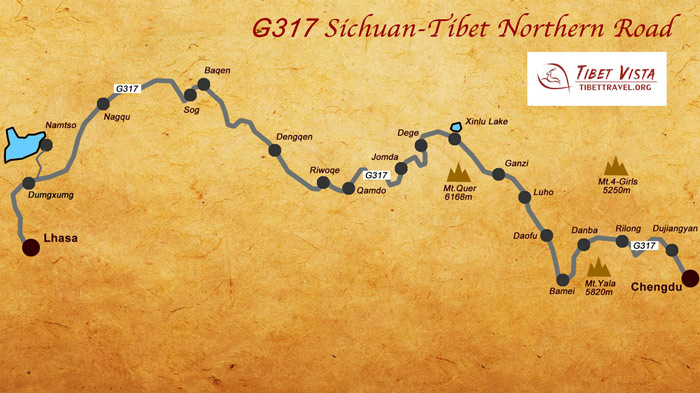 (Simple click to enlarge the map)
(Simple click to enlarge the map)
Sichuan Tibet Highway Northern Route Map
The Sichuan-Tibet Highway, originally called the Kangding-Tibet Highway, takes you through vast, open landscapes with majestic peaks vaulting skyward. The plateau areas are dotted with castellated Tibetan homes and an infinite number of contentedly munching yaks. Travelers can enjoy the magnificent and changeable scenery ranging from warm spring to cold and snowing winter. The climate can change in front of your eyes, and can make you think you are on a different planet.
Noted as one of the most dangerous roads in the world by many organizations and news articles, the highway is infamously known for the bad driving surfaces and sharp mountain hairpin bends. Many sections of the road are only single track, and driving long them in bad weather is a dangerous challenge to a less experienced driver. Landslides and rock avalanches are also common along the route. There are many dangerous sections of road along the route, and oxygen is scarce in the high altitude, making driving even more of a challenge.
On top of the normal dangers of the route, there are also many challenges of your driving skills, such as the 99-turns section, which makes an extended series of switchbacks as the road swings down the mountainside. Rain, ice, snow and a host of other chilly winter challenges last for close to ten months making driving along this road a treacherous journey even for most experienced driver. The road is not paved, which makes it a mud trap during the rainy season, and you will often come across thousand-car traffic jams stretching for miles.
However, the route also takes you through some of the most beautiful countryside, and into towns and villages where you can explore the more ancient Tibetan monasteries, most notably Larung Gar Buddhist Academy and Derge Parkhang, with many local people still living in the same way as they did in the days of Songtsen Gampo. And, while the road may be dangerous, it is intensely beautiful, with scenery that will constantly leave you in awe, and take your breath away every time you crest a mountain pass and view the scenery below.
Best Time to Enjoy a Road Trip via G317 National Highway
May to June
Traveling in May and June is one of the best options when driving along the Northern Route to Lhasa. Once the thaws of spring are over, the roads start to dry up a little, and the previously muddy sections of the route turn to dusty sections, which are a little less dangerous. The weather is also brighter, with clear skies and great views as you traverse this long and winding road.
July to August
July and August is, traditionally, the rainy season for this part of Tibet. The Southeastern areas of Tibet are lower in comparison with the rest of the plateau, and rains are more frequent in the monsoon season. Landslides and mudslides can often occur, with the debris being loosened by the heavy downpours and spilling across the road. The dirt sections of the road also become muddy bogs that can drag down a vehicle, and leave you stuck with no way out. This time of year, however, is also one of the popular times for the local festivals, and along the route there are several horse racing festivals in the high pastures around Nagqu.
September to October
With the end of the rainy season comes autumn, and the drier, clearer weather means the road is more open to travel again, and less prone to rockslides, although it can still happen. The clearest skies of the year, autumn is an ideal time to adventure along the road and see the high, snow-capped mountain peaks that spear the clear blue sky. Certain mountains along this route should definitely not be missed.
November to February
The winter comes in quickly in the region, and by mid-November the snows have normally started to fall in the higher areas of the route. With more than a dozen high mountains over 4,000 meters along the road, snowdrifts that block the road are a frequent occurrence, and the snows can last until at least February. Driving at this time is highly risky, with freezing temperatures, icy tracts of road, and very few places to stay overnight along the route.
Highlights of G317 Highway from Chengdu to Lhasa
Mount Siguniang
Mount Siguniang, the highest peak of Eastern Hengduan Range, is located in the bordering area of Xiaojin County and Wenchuan County in Ngawa Tibetan and Qiang Autonomous Prefecture, Sichuan Province. With a similar layout of the South European scenery, Mount Siguniang is also called the Chinese Alps. Mount Siguniang is well-known for its grandness, straightness and forcefulness. It is a natural forest area with abundant forest, thick green grass, and clear flowing rivers.
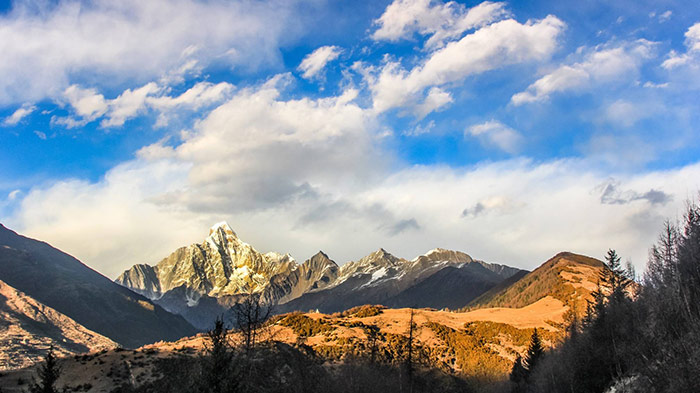 Mount Siguniang - The Highest Peak of Eastern Hengduan Range
Mount Siguniang - The Highest Peak of Eastern Hengduan Range
Jiaju Tibetan Village
Known as the "Tibetan Fairyland", Jiaju Tibetan Village is a great destination for photography. It is one of the most beautiful ancient villages, and is a place with a graceful idyllic life, hiding among the mountains. The village lies around 13 hours from Chengdu, and there are a lot of beautiful natural landscapes on the way. In the village, there are about 140 Tibetan-style houses, which are all distinctive with their crown-shaped roofs, red eaves and white walls. From time to time, you can see smoke curling up from kitchen chimneys, which forms an Arcadian picture scroll together with the liquid brooks, the pure white snow peaks and the valley filled up with mist.
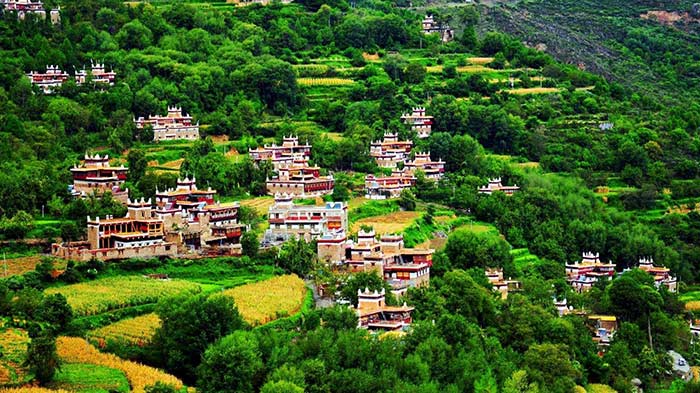 Jiaju Tibetan Village - Known as the "Tibetan Fairyland"
Jiaju Tibetan Village - Known as the "Tibetan Fairyland"
Tagong Grassland
Tagong Grassland is located in Tagong Town, Kangding at an elevation of 3730 meters, and is about 113 kilometers from Kangding. Backing against the famous Haizi Shan Mountain, Tagong Grassland is a very flat terrain, with plenty water and lush grass, as well as flocks and herds of wild and domestic animals. There are also some great spots to visit, such as Tagong Temple, Muya Gold Tower and Yala Snow Mountain.
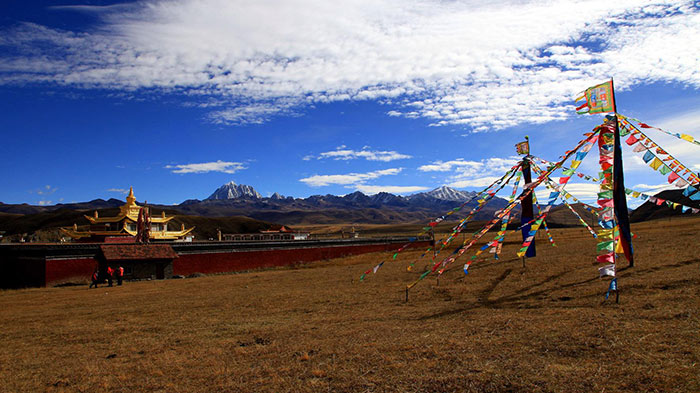 Tagong Grassland - Tagong Temple
Tagong Grassland - Tagong Temple
Kandze Monastery
Situated 2 km north of Garzê Town on a hilltop overlooking the town, lies Kandze Monastery, a 17th century monastery that was built by the Mongols, and was once the largest monastery in Kham. It has been extensively renovated since 1981 and now houses about 700 monks, including three tulkus - one of whom returned from Switzerland and established a girls' school.
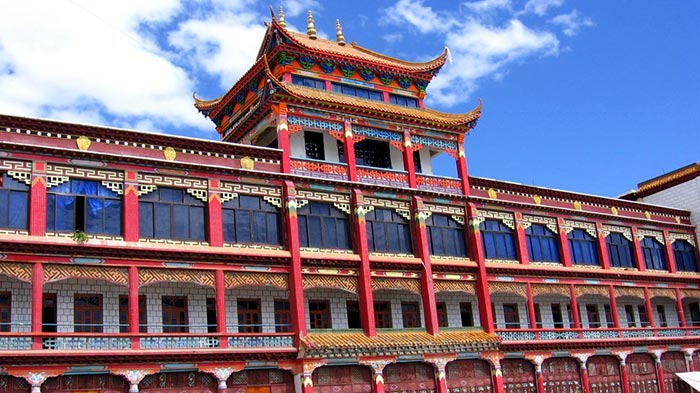 Kandze Monastery - The Largest Monastery in Kham
Kandze Monastery - The Largest Monastery in Kham
Larung Gar Buddhist Academy
One of the top sights along the route is the Larung Gar Buddhist Academy. Spread among the hills in Serta County in Kardze, eastern Tibet, Larung Gar is the largest and one of the most significant sites in Tibetan Buddhism. It was established in 1980 and has grown over the years to become home to anywhere between 10,000 and 40,000 residents. These residents include monks, nuns and visiting students, who come from Tibet, China and other countries to learn.
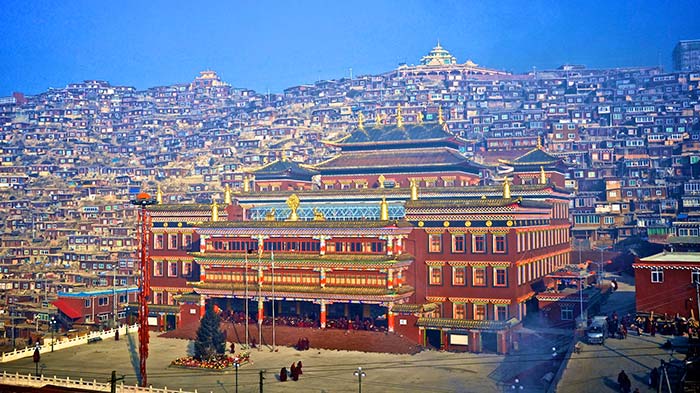 Larung Gar Buddhist Academy - The Largest and One of the Most Significant Sites in Tibetan Buddhism
Larung Gar Buddhist Academy - The Largest and One of the Most Significant Sites in Tibetan Buddhism
Derge Parkhang
A unique sight along the route is the monastery of Derge Parkhang, which was established in 1729 by King Tenpa Tsering. It houses printing blocks for the Derge edition of the Kangyur, edited by Situ Paṅchen Chokyi Jungne, and Tengyur, edited by Zhuchen Tsultrim Rinchen, under the patronage of King Lhachen Puntsok Tenpa, as well as a vast collection of other texts from every religious tradition of Tibet.
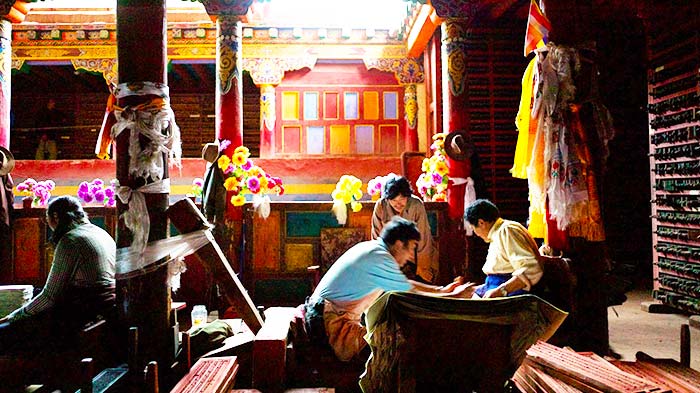 Derge Parkhang - A Unique Sight along Northern Route
Derge Parkhang - A Unique Sight along Northern Route
Galden Jampaling Monastery
Galden Jampaling Monastery is located at the junction of the Angqu River and the Zaqu River in Chamdo. It is also known as Qambaling Monastery, Changbalin Monastery, or Qiangbalin Monastery. Tsongkhapa’s disciple constructed the monastery between 1436 and 1444. The main Buddha in the monastery is Byams-pa, hence the name. Jampaling Monastery houses five living Buddha lineages and 12 dratsangs, and during its heyday, it had more than 5000 monks and administrated 70 smaller monasteries around it.
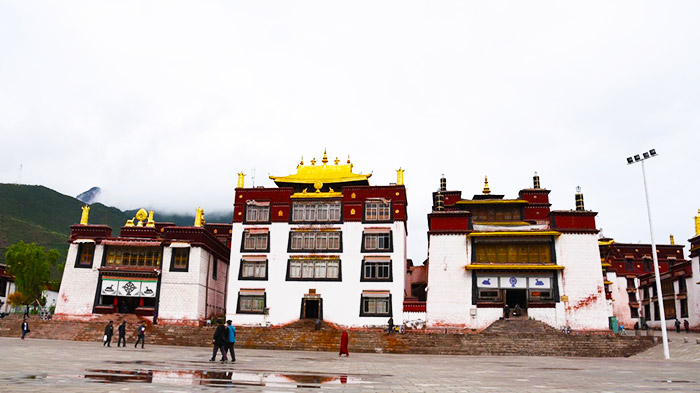 Galden Jampaling Monastery - Had more than 5000 Monks around it.
Galden Jampaling Monastery - Had more than 5000 Monks around it.
Zizhu Temple
Zizhu Temple is one of the highest temples in Tibet, at 4,850 meters, and one of the oldest and most important temples of Bonism. The largest prehistory religion temple with the most religious and cultural conventions being reserved, it still keeps the complete Bon classics and the practice method of the mysterious Bon yoga. Insider Tips: Unfortunately, Zizhu Temple is currently unavailable to foreign tourists.
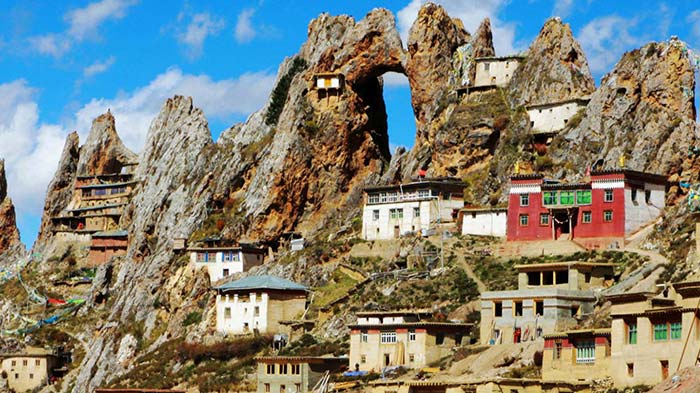 Zizhu Temple - One of the Highest Temples in Tibet
Zizhu Temple - One of the Highest Temples in Tibet
Namtso Lake (Star Attraction)
Namtso Lake, located the northwest of Lhasa is the highest saltwater lake in the world with an altitude of 4718 meters. In Tibetan, Namtso means Heavenly Lake, and it is one of the three holy lakes in Tibet, together with Yamdrok Lake and Lake Manasarovar. Consisting of over 1,500 lakes and five big islands, which used to be spiritual retreats for monks, Namtso is a paradise of nature and a wonderful place for photography.
.jpg) Namtso Lake - One of the Three Holy Lakes in Tibet
Namtso Lake - One of the Three Holy Lakes in Tibet
Yangpachen Hot Spring
In an upland, lush green valley, surrounded by the tents of nomads with grazing yak and sheep populating the hillside, lies the famous Yangpachen hot Springs, which have been harnessed to produce much of the electricity for the capital Lhasa. There is a thermoelectric power plant on the edge of the Yangpachen hot springs field covering 20–30 square kilometers. The thermoelectric power plant was established in 1976, and the first development of geothermal power in China. You can get rid of your tiredness by dipping into the steamy hot springs.
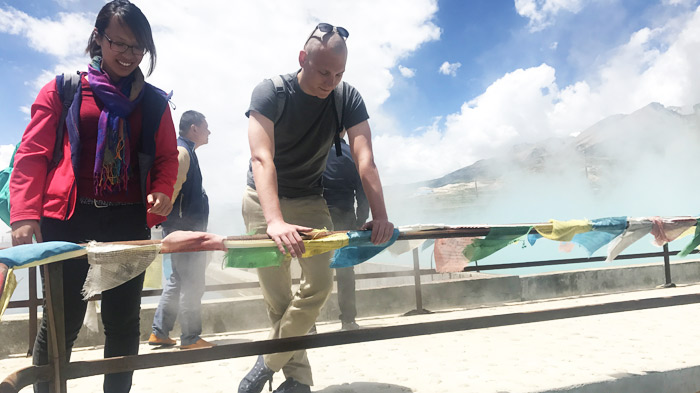 Yangpachen Hot Spring
Yangpachen Hot Spring
Travel Documents Needed
Tibet is a region of China that has strict policies on foreign travelers traveling unaccompanied. Any foreign traveler that intends to take the Sichuan-Tibet Highway to Lhasa needs to book Tibet tour through a registered tour operator, such as Tibet Vision, and travel in the company of one of their local guides. The advantage of this is that the guides will know the road well , and be better prepared for any incidents that may occur.
There are also certain permits that are needed for the trip to Lhasa, which can only be obtained by the tour operator before you leave Chengdu. The first permit is the Tibet Travel Permit, which is issued by the Tibet Tourism Bureau in Lhasa, and is needed for all foreign travelers to enter Tibet. You will also need the Alien’s Travel Permit, which is required for all travel outside Lhasa city, the capital of Tibet. Since the route along the highway enters Tibet long before you reach Lhasa, the permit will be obtained by the tour operator before you leave Chengdu, instead of the guide processing it in Lhasa. There is also a Military Permit, which is required for travel to certain military-sensitive areas of Tibet.
Packing List
As with all tours to Tibet, warm clothing is a must. Although the weather can be warmer in the peak seasons, it can still get very cold at night, especially if you are camping along the route. Ensure you have plenty of warm clothes, as well as thick socks and strong, sturdy walking boots, as the terrain can be a little rough when taking time out to do some scenic sightseeing.
Medicines should be kept with you, especially if you have to take regular medication, and talk to your doctor about altitude sickness medication before you leave, to make sure you can take it if necessary. A small first aid kit is an advantage, and make sure you have a hat, sunglasses, sun cream, and lip balm. The sun can still burn, despite the colder climate, and the wind is strong enough to chap lips very quickly in the cold air. Another good tip is to bring spare batteries for your cameras and cellphones, etc. There are not always places where you can get a charge when out on the road, and you do not want to miss that perfect photo.
Dining and Accommodation
When the weather is bright, and there are no snows on the ground, there are a good selection of hotels, hostels, and lodges along the Northern Route that cater to foreign and local travelers. The accommodation is well kept and clean, and the prices are reasonable, considering it is the most used highway to Tibet. There are other forms of accommodation along the highway, which are more for the truckers that ply the route to Lhasa, and where foreign tourists are not normally allowed to stay.
Food in most places along the highway is a mix of Sichuan dishes and Tibetan cuisine. You can also find a few of the old favorites for tourists in some of the diners and lodges, such as pasta, pizza, etc, but for the most part, the food is all local. If you are not into Sichuan cuisine or Tibetan dishes, it is advisable to take some package food with you for the trip.





35 Comment ON "Guide to Sichuan-Tibet Highway Northern Route via G317"
Asked by Liliana Me** from Macau
plan a 7-8days trip for me and my boyfriend in April
Hi! I would like to plan a 7-8days trip for me and my boyfriend in April (3rd to 10th ideally) to Nepal, Tibet, and, if possible, Bhutan. Do you think it would be doable? Based on what I read, there are some places/things to do to consider: Nepal: Everest Base Camp trek and the Annapurna Circuit, ancient temples, sacred sites like Lumbini, Kathmandu, Tibet: The Potala Palace in Lhasa and the Jokhang Temple. eventually the holy Mount Kailash or the high-altitude plains. Bhutan: Thimphu, Paro, and the famous Tiger’s Nest Monastery. To take part in cultural traditions, yoga, meditation... Of course I am open to any recommendations you could make. For your reference, we are both based in Asia: him, in Bangkok and myself in Macau. Thank you so much for the information you could provide and, if possible, an estimated budget for your offer.
Asked by Ke** from Singapore
Cycling Tour to Mt Kailash
Hi , we are planning a Cycling Trip once Tibet opens for Tourism. The plan is we shall arrive to Kathmandu , travel to the border and enter via Kerung. Can you pls send a day to day Itinerary starting from Kerung - Lake Manasarovar - Darchen - Asthapath. We shall go around Kailash on foot and resume Cycling back to Kerung. We are a Group of 6-8 persons. Thanks Pls send ur reply to Kevin
Asked by Debo** from USA
Please can you tell me the prices and dates for the Tibet Luxury Tour.
Also, could you please provide a detailed itinerary - I want to see how many hours are spent on buses/vehicles. Thank you! Deborah
Asked by S** from HongKong
Tibet Tour from HK
May I know if holding Mainland Travel Permit for HK Residents. is it also need to get the visa permit to Tibet and what is the procedure if need to apply? Thank you
Asked by Na** from USA
Is Kailash Mansarovar Trip open for Indian Passport Holder?
Is it open for Indian Passport Holder?
Asked by A** from Singapore
Enquiry on private tour
We are planning a trip from Hong Kong to Tibet during the 12th to 21st of April. We want a private tour that covers all the scenic places as well as the EBC. Please advise an itinerary along with the cost breakdown. Thanks.
Asked by Na** from Canada
We would like to take the train from Xining to Lhasa
Asked by Gr** from Canada
The "Tibet Entry Permit" should be apply
Asked by Tam** from Singapore
Sightseeing Potala Palace
Asked by Ka** from Singapore
plan to travel to Mount Kailash